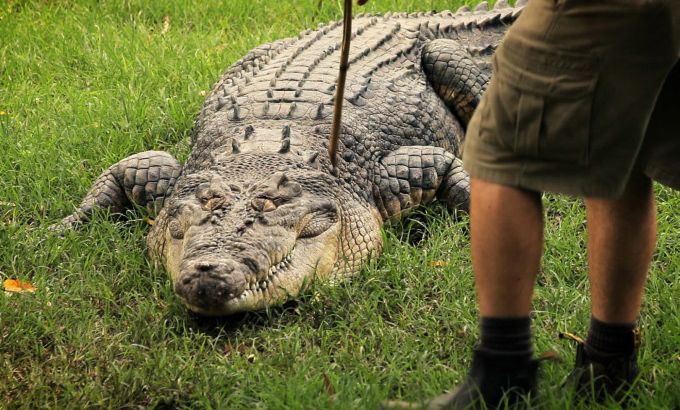
Cane Toads
earthrise learns about a vital breakthrough in Australia’s lethal war against poisonous cane toads.
Predatory, poisonous, pestilent and bloody-mindedly persistent: the South American cane toad is the eco-scourge of Australia. Ranked 16th on the World’s 100 Worst Invasive Species list, Bufo marinus was introduced to Australia in the early 20th century in a bid to control crop-devouring sugar-cane beetles. The experiment was a disaster: not only did the toads completely ignore the bugs they were supposed to eradicate, but in a few short years they proved themselves highly adaptable, prolific breeders and more-or-less indestructible.
This nightmare scenario has seen more than 200 million of these monster toads – which can weigh well over 2kg each – on an unstoppable march across the north of Australia. They have led to the severe decline of the Northern Quoll (a relative of the Tasmanian Devil) in the Northern Territory, as well as native snakes, goannas, freshwater crocodiles and at least 10 frog species. Incubators of salmonella, frog-killing myxosporean parasites and the noxious bufotoxin poison, the toads cause chaos in delicate ecosystems by spreading disease, destroying habitats and causing food chain instability.
Vast amounts of funding, endless community initiatives and countless failed vaccines have gone into battle against the feral toad. But it is simple science – with a touch of romance – that may finally win the war. Researchers in Australia’s far north have developed a unique trap that could spell doom for the most menacing cane toad of them all: the exceptionally fecund female.
While male toads are relatively simple to catch, the wily female – who can lay an astonishing 30,000 eggs in one sitting – has proven a more elusive target. But by playing up to females’ predilection for full-voiced mates, scientists at Townsville’s James Cook University have come up with a solution that increases trapping success by as much as 300 per cent. By emitting low-frequency, high-pulse-rate calls that signify what project leader Lin Schwarzkopf calls “the toad version of Barry White” and incorporating attractive, specially-designed “mood lighting”, the new female toad traps are snaring potential breeders in unprecedented droves, and may prove to be a vital breakthrough in Australia’s lethal war against the toad.
Tamara Sheward travels to North Queensland to see Schwarzkopf’s ingenious trap in action, and joins a group of no-nonsense suburban children on a “toad muster” – a mass (humane) amphibian ambush.
| earthrise blog: Tamara Sheward |
If you sidle up to just about anyone in Australia and whisper the words “cane toad” you are almost guaranteed to cop a blast of obscenities. Such is the emotive power of bufo marinus, Australia’s most disliked living creature and one of the world’s most damaging invasive species.
A long time ago, at journalism school, we were taught to remain objective at all times. Obviously, my urbane lecturers had never accidentally trodden – barefoot – on a writhing, toxic toad in their backyard in the middle of the night, nor witnessed the painful death of a pet puppy after it had swallowed one of the poisonous predators. I grew up less than 30km from where the plague of cane toads was first unleashed in Australia, and spent years watching helplessly as they out-ate and outnumbered native frogs and lizards across the tropics. No, forget the journalistic code. This time, it is personal.
In my weeks of research, I not only lost two kilos (you try eating your lunch with a monitor aglow with toadflesh), but also all notions of ‘live and let live’. Cane toads – first brought to Australia from Hawaii with the unsuccessful aim of combatting a sugarcane-devouring beetle – were more of a menace than I had ever imagined.
Armies of toads – 200 million of them, at last estimate – have spread almost unchecked across this vast continent, dominating ecosystems, poisoning marine life, and in some cases, entirely decimating local populations of native wildlife. I also became hideously well-versed in toady trivia: did you know that each year 200 tonnes of toads are squashed on Queensland roads alone? Little wonder I felt queasy.
Almost as nauseating was the dawning realisation that, during the making of this film, I would be forced to actually handle cane toads. Come the evening of the Great earthrise Toad Hunt – in a Townsville park that throbbed with the drumming call of cane toads – I found myself standing petrified in the gloom, awkwardly waving a torch at the toads I did not want to find, as dozens of children swooped and whooped around my shaking frame: “I’ve got one!”, “Look at this one, it’s MASSIVE!”, “Cool! It’s jumping up my leg!”.
I must have audibly gagged, because a solemn young man of perhaps 10 years old came up and handed me his gloves. I pulled them on and pointed out to my director, Tony, that I would still be able to feel the toads. Tony eyed the kids fearlessly seizing toads like they were lollies from a piñata, then glared at me in the darkness: “GO!”
My body absolutely refused to move, even when four idiotically-belching toads sat within easy grabbing distance: I have been parachuting, and found it far easier to hurl myself out of a plane at 14,000 feet than to bend over and pluck a 10cm amphibian off the ground. But finally, somehow, I felt my body jerk … then stagger … then seize. Oh, my word. I had caught a cane toad.
Added to their loathsome behaviour and the environmental nightmare that their introduction created, cane toads are physically vile (I did say this was personal). Unlike frogs, the toads are fairly dry, almost leathery with a corpse-like rasp to the skin. Until, that is, they start secreting wet poison, which looks like unsavoury bubbles of pus.
As I clung to my toad, encircling it just above its back legs, I felt it angrily try to worm out of my hand. There was just something so offensive about its tenacity, its hardiness, its fierce struggle to escape. At that moment a nine-year-old plucked it from my grip and dropped it in her toad bucket with a carefree (and barehanded) “Ta!”
I would like to say it got easier for me, Miss Yellowbelly 2012, as the shoot went on. But alas: if this is what they call “aversion therapy”, I am not buying it. I caught a feeble total of four toads in the park, as compared to the child-warriors, who ran through the dark screaming “48!” “No, 52!” But now, I can bask in the warm, lofty glow of “Doing it for the greater good!” If this programme and the innovation featured in it can get us one step closer to the eradication of cane toads in Australia, then it was all worth it.
Just do not ask me to do it again.
earthrise airs each week at the following times GMT: Friday: 1930; Saturday: 1430; Sunday: 0430; Monday: 0830. Click here for more on earthrise. |
